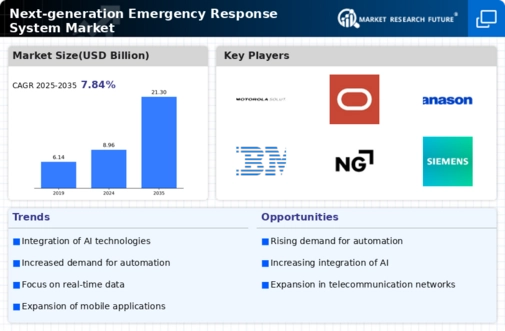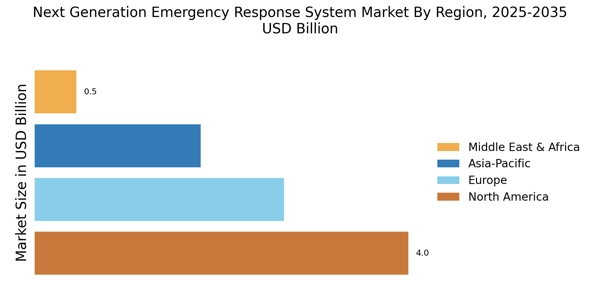Growing Urbanization
Urbanization is a significant factor influencing the Next Generation Emergency Response System Market. As populations migrate to urban areas, the complexity of emergency response increases due to higher population densities and infrastructure challenges. Urban centers are often more susceptible to various emergencies, including natural disasters, accidents, and public health crises. This necessitates the development of sophisticated emergency response systems that can effectively manage these challenges. The market is expected to expand as cities invest in next-generation systems to enhance their preparedness and response capabilities. With urban populations projected to reach 68% by 2050, the demand for advanced emergency response solutions will likely escalate.
Technological Advancements
The Next Generation Emergency Response System Market is experiencing a surge in technological advancements that enhance the efficiency and effectiveness of emergency response operations. Innovations such as artificial intelligence, machine learning, and advanced data analytics are being integrated into emergency response systems. These technologies enable real-time data processing and predictive analytics, which can significantly improve decision-making during emergencies. For instance, AI-driven algorithms can analyze vast amounts of data to identify patterns and predict potential emergencies, thereby allowing responders to act proactively. The market is projected to grow at a compound annual growth rate of approximately 10% over the next five years, driven by these technological innovations that promise to revolutionize emergency management.
Regulatory Compliance and Standards
The Next Generation Emergency Response System Market is also driven by the need for regulatory compliance and adherence to safety standards. Governments and regulatory bodies are increasingly establishing stringent guidelines for emergency response systems to ensure public safety. Compliance with these regulations often requires the adoption of advanced technologies and methodologies, which can enhance the overall effectiveness of emergency response efforts. For instance, many jurisdictions are mandating the integration of interoperable communication systems to facilitate coordination among various emergency services. This regulatory push is likely to propel the market forward as organizations strive to meet compliance requirements while improving their response capabilities.
Increased Investment in Public Safety
Investment in public safety initiatives is a critical driver for the Next Generation Emergency Response System Market. Governments and private sectors are increasingly allocating funds to enhance emergency response capabilities. This trend is evident in various regions where budgets for emergency services have seen substantial increases. For example, in recent years, several countries have reported a rise in funding for emergency services, with some allocating over 15% of their public safety budgets to upgrade response systems. This influx of capital is facilitating the adoption of advanced technologies and training programs, ultimately leading to more efficient emergency response mechanisms. As public safety becomes a priority, the market is likely to witness sustained growth.
Public Awareness and Preparedness Initiatives
Public awareness and preparedness initiatives are vital drivers of the Next Generation Emergency Response System Market. As communities become more aware of potential risks and emergencies, there is a growing demand for effective response systems. Educational campaigns and training programs aimed at enhancing public preparedness are being implemented across various regions. These initiatives not only empower individuals to respond effectively during emergencies but also create a demand for advanced emergency response technologies. The market is likely to benefit from this increased focus on preparedness, as organizations seek to develop systems that can support community resilience and enhance overall emergency management strategies.


















Leave a Comment